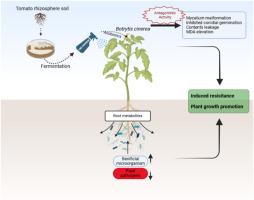Biocontrol potential of Streptomyces alboflavus LNU-CPARS28 against tomato gray mold caused by Botrytis cinerea
IF 3.3
3区 农林科学
Q2 PLANT SCIENCES
引用次数: 0
Abstract
Tomato gray mold, caused by the necrotrophic fungal pathogen Botrytis cinerea, represents one of the most destructive diseases affecting tomato cultivation worldwide. While chemical fungicides remain the predominant control method, their intensive and prolonged application has resulted in significant environmental contamination and the emergence of resistant pathogen strains. In recent years, the utilization of antagonistic actinobacteria has emerged as a promising sustainable alternative for plant pathogen management. In this study, we demonstrated that Streptomyces alboflavus LNU-CPARS28 with strong antifungal activity against B. cinerea (85.56 ± 0.83 %) by inhibiting the mycelium growth and spores germination, disrupted the cell membrane, and caused mycelium deformation and the leakage of cellular contents. Its cell-free culture filtrate significantly reduced the infection of B. cinerea to tomato gray mold (with a control efficacy of 90.00 ± 0.58 %). Additionally, the strain demonstrated resistance-inducing properties in tomato seedlings. It also positively modulated the structure and function of the tomato rhizosphere microbial community by recruiting microbes associated with disease resistance while significantly upregulating metabolic pathways related to energy metabolism in tomato plants. These findings suggested that S. alboflavus LNU-CPARS28 shows strong potential as a biocontrol agent for the managing tomato gray mold.

白黄链霉菌LNU-CPARS28对番茄灰霉病的防效研究
番茄灰霉病是由番茄灰霉病致病菌灰霉病引起的,是世界范围内影响番茄种植最具破坏性的病害之一。虽然化学杀菌剂仍然是主要的防治方法,但它们的大量和长期使用导致了严重的环境污染和耐药病原菌的出现。近年来,利用拮抗放线菌已成为植物病原体管理的一种有前景的可持续替代方法。本研究表明,白黄链霉菌LNU-CPARS28通过抑制菌丝生长和孢子萌发,破坏细胞膜,引起菌丝变形和细胞内容物渗漏,对灰绿杆菌具有较强的抗真菌活性(85.56±0.83%)。其无细胞培养滤液可显著降低番茄灰霉病菌对番茄灰霉病菌的侵染率(防治效果为90.00±0.58%)。此外,该菌株在番茄幼苗中表现出抗性诱导特性。它还通过招募与抗病相关的微生物来正向调节番茄根际微生物群落的结构和功能,同时显著上调番茄植株中与能量代谢相关的代谢途径。这些结果表明,黄曲霉LNU-CPARS28在防治番茄灰霉病方面具有很强的潜力。
本文章由计算机程序翻译,如有差异,请以英文原文为准。
求助全文
约1分钟内获得全文
求助全文
来源期刊
CiteScore
4.30
自引率
7.40%
发文量
130
审稿时长
38 days
期刊介绍:
Physiological and Molecular Plant Pathology provides an International forum for original research papers, reviews, and commentaries on all aspects of the molecular biology, biochemistry, physiology, histology and cytology, genetics and evolution of plant-microbe interactions.
Papers on all kinds of infective pathogen, including viruses, prokaryotes, fungi, and nematodes, as well as mutualistic organisms such as Rhizobium and mycorrhyzal fungi, are acceptable as long as they have a bearing on the interaction between pathogen and plant.

 求助内容:
求助内容: 应助结果提醒方式:
应助结果提醒方式:


